Analysis of Marketing Concepts and Demographic Impact
VerifiedAdded on 2020/03/23
|6
|1539
|74
Homework Assignment
AI Summary
This assignment analyzes marketing concepts within the context of a non-profit organization, specifically the Red Cross, examining their application of marketing strategies and the importance of consumer satisfaction. It contrasts this with the marketing approach of for-profit entities, highlighting the shift towards consumer-centric strategies. The assignment further investigates the influence of worldwide demographic trends on international marketing, focusing on how factors like the ratio of children to older persons, the emergence of diseases, the speed of aging, dependency of the old age, and reduced child dependency affect marketing strategies. The assignment also identifies industries, such as insurance and healthcare, that are poised to benefit from the aging baby boomer population, emphasizing the need for businesses to adapt their marketing approaches to cater to these evolving demographics. The analysis includes a review of the Billabong website and how organizations communicate with consumers.
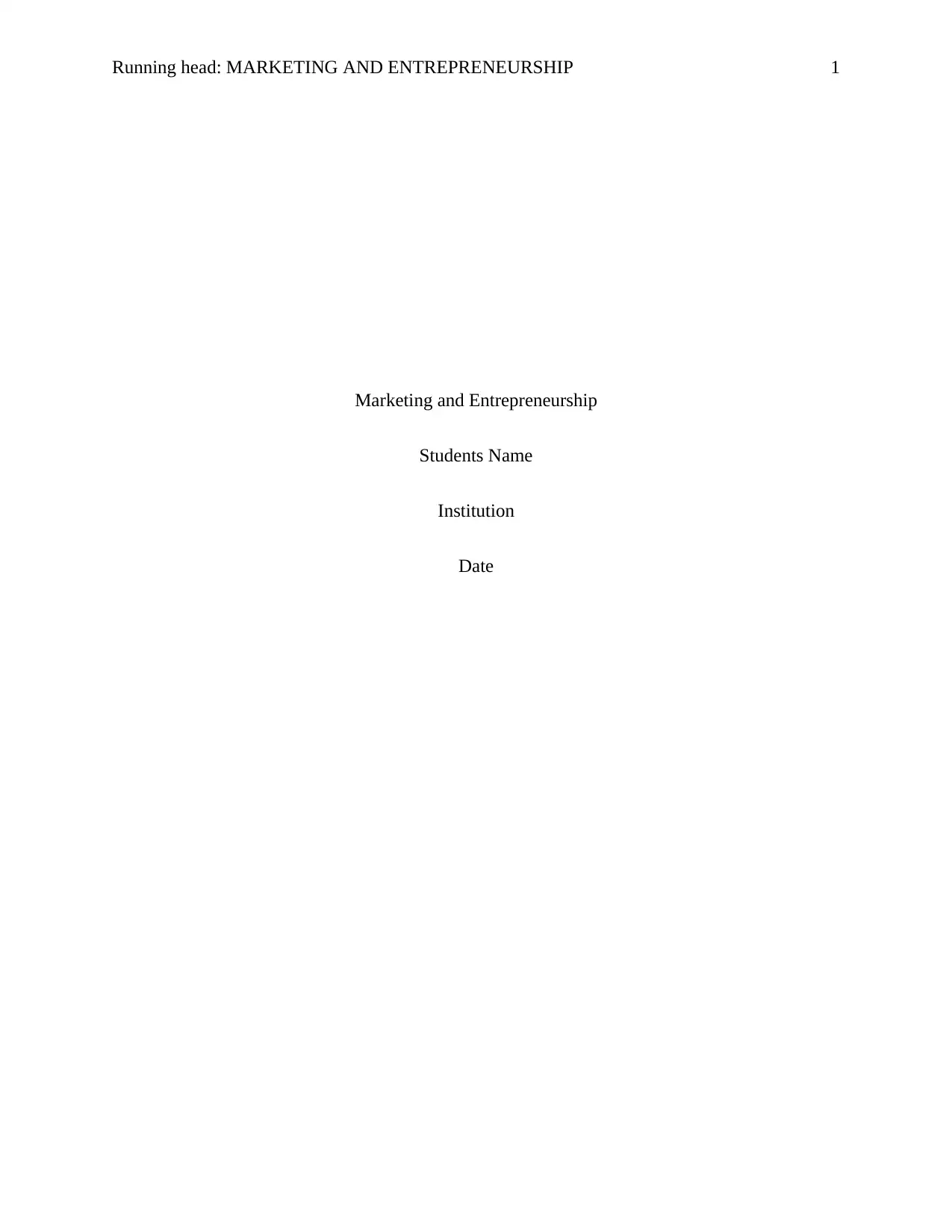
Running head: MARKETING AND ENTREPRENEURSHIP 1
Marketing and Entrepreneurship
Students Name
Institution
Date
Marketing and Entrepreneurship
Students Name
Institution
Date
Paraphrase This Document
Need a fresh take? Get an instant paraphrase of this document with our AI Paraphraser
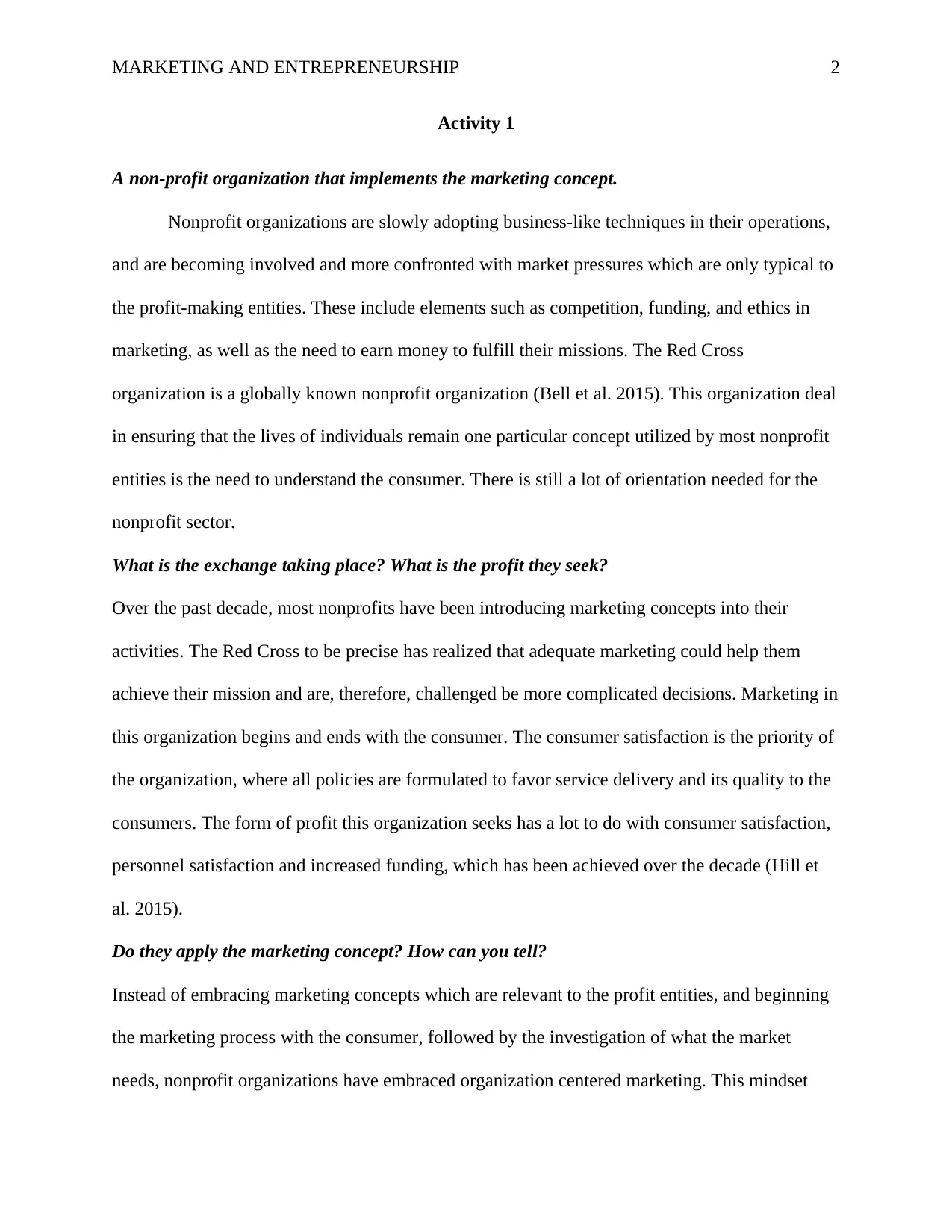
MARKETING AND ENTREPRENEURSHIP 2
Activity 1
A non-profit organization that implements the marketing concept.
Nonprofit organizations are slowly adopting business-like techniques in their operations,
and are becoming involved and more confronted with market pressures which are only typical to
the profit-making entities. These include elements such as competition, funding, and ethics in
marketing, as well as the need to earn money to fulfill their missions. The Red Cross
organization is a globally known nonprofit organization (Bell et al. 2015). This organization deal
in ensuring that the lives of individuals remain one particular concept utilized by most nonprofit
entities is the need to understand the consumer. There is still a lot of orientation needed for the
nonprofit sector.
What is the exchange taking place? What is the profit they seek?
Over the past decade, most nonprofits have been introducing marketing concepts into their
activities. The Red Cross to be precise has realized that adequate marketing could help them
achieve their mission and are, therefore, challenged be more complicated decisions. Marketing in
this organization begins and ends with the consumer. The consumer satisfaction is the priority of
the organization, where all policies are formulated to favor service delivery and its quality to the
consumers. The form of profit this organization seeks has a lot to do with consumer satisfaction,
personnel satisfaction and increased funding, which has been achieved over the decade (Hill et
al. 2015).
Do they apply the marketing concept? How can you tell?
Instead of embracing marketing concepts which are relevant to the profit entities, and beginning
the marketing process with the consumer, followed by the investigation of what the market
needs, nonprofit organizations have embraced organization centered marketing. This mindset
Activity 1
A non-profit organization that implements the marketing concept.
Nonprofit organizations are slowly adopting business-like techniques in their operations,
and are becoming involved and more confronted with market pressures which are only typical to
the profit-making entities. These include elements such as competition, funding, and ethics in
marketing, as well as the need to earn money to fulfill their missions. The Red Cross
organization is a globally known nonprofit organization (Bell et al. 2015). This organization deal
in ensuring that the lives of individuals remain one particular concept utilized by most nonprofit
entities is the need to understand the consumer. There is still a lot of orientation needed for the
nonprofit sector.
What is the exchange taking place? What is the profit they seek?
Over the past decade, most nonprofits have been introducing marketing concepts into their
activities. The Red Cross to be precise has realized that adequate marketing could help them
achieve their mission and are, therefore, challenged be more complicated decisions. Marketing in
this organization begins and ends with the consumer. The consumer satisfaction is the priority of
the organization, where all policies are formulated to favor service delivery and its quality to the
consumers. The form of profit this organization seeks has a lot to do with consumer satisfaction,
personnel satisfaction and increased funding, which has been achieved over the decade (Hill et
al. 2015).
Do they apply the marketing concept? How can you tell?
Instead of embracing marketing concepts which are relevant to the profit entities, and beginning
the marketing process with the consumer, followed by the investigation of what the market
needs, nonprofit organizations have embraced organization centered marketing. This mindset
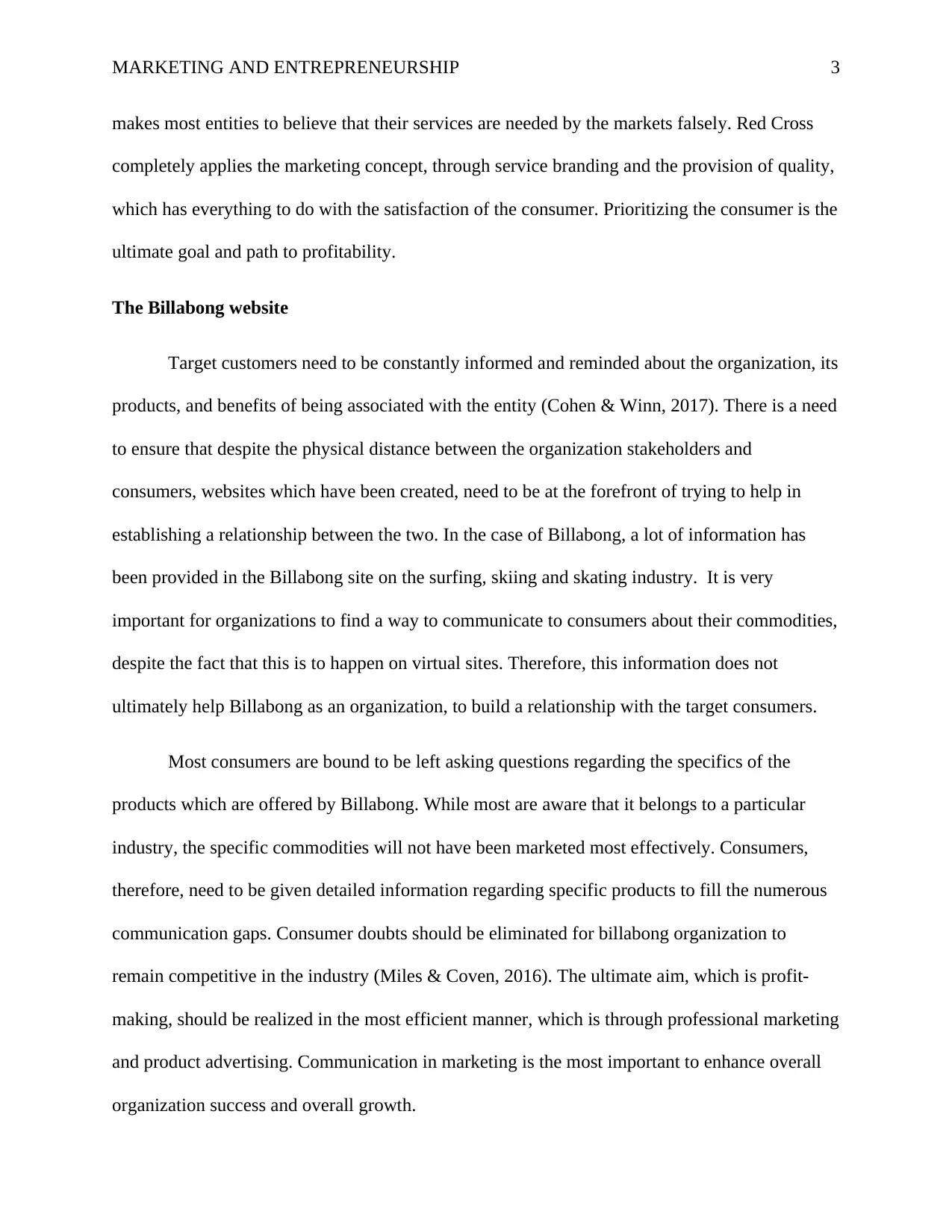
MARKETING AND ENTREPRENEURSHIP 3
makes most entities to believe that their services are needed by the markets falsely. Red Cross
completely applies the marketing concept, through service branding and the provision of quality,
which has everything to do with the satisfaction of the consumer. Prioritizing the consumer is the
ultimate goal and path to profitability.
The Billabong website
Target customers need to be constantly informed and reminded about the organization, its
products, and benefits of being associated with the entity (Cohen & Winn, 2017). There is a need
to ensure that despite the physical distance between the organization stakeholders and
consumers, websites which have been created, need to be at the forefront of trying to help in
establishing a relationship between the two. In the case of Billabong, a lot of information has
been provided in the Billabong site on the surfing, skiing and skating industry. It is very
important for organizations to find a way to communicate to consumers about their commodities,
despite the fact that this is to happen on virtual sites. Therefore, this information does not
ultimately help Billabong as an organization, to build a relationship with the target consumers.
Most consumers are bound to be left asking questions regarding the specifics of the
products which are offered by Billabong. While most are aware that it belongs to a particular
industry, the specific commodities will not have been marketed most effectively. Consumers,
therefore, need to be given detailed information regarding specific products to fill the numerous
communication gaps. Consumer doubts should be eliminated for billabong organization to
remain competitive in the industry (Miles & Coven, 2016). The ultimate aim, which is profit-
making, should be realized in the most efficient manner, which is through professional marketing
and product advertising. Communication in marketing is the most important to enhance overall
organization success and overall growth.
makes most entities to believe that their services are needed by the markets falsely. Red Cross
completely applies the marketing concept, through service branding and the provision of quality,
which has everything to do with the satisfaction of the consumer. Prioritizing the consumer is the
ultimate goal and path to profitability.
The Billabong website
Target customers need to be constantly informed and reminded about the organization, its
products, and benefits of being associated with the entity (Cohen & Winn, 2017). There is a need
to ensure that despite the physical distance between the organization stakeholders and
consumers, websites which have been created, need to be at the forefront of trying to help in
establishing a relationship between the two. In the case of Billabong, a lot of information has
been provided in the Billabong site on the surfing, skiing and skating industry. It is very
important for organizations to find a way to communicate to consumers about their commodities,
despite the fact that this is to happen on virtual sites. Therefore, this information does not
ultimately help Billabong as an organization, to build a relationship with the target consumers.
Most consumers are bound to be left asking questions regarding the specifics of the
products which are offered by Billabong. While most are aware that it belongs to a particular
industry, the specific commodities will not have been marketed most effectively. Consumers,
therefore, need to be given detailed information regarding specific products to fill the numerous
communication gaps. Consumer doubts should be eliminated for billabong organization to
remain competitive in the industry (Miles & Coven, 2016). The ultimate aim, which is profit-
making, should be realized in the most efficient manner, which is through professional marketing
and product advertising. Communication in marketing is the most important to enhance overall
organization success and overall growth.
⊘ This is a preview!⊘
Do you want full access?
Subscribe today to unlock all pages.

Trusted by 1+ million students worldwide
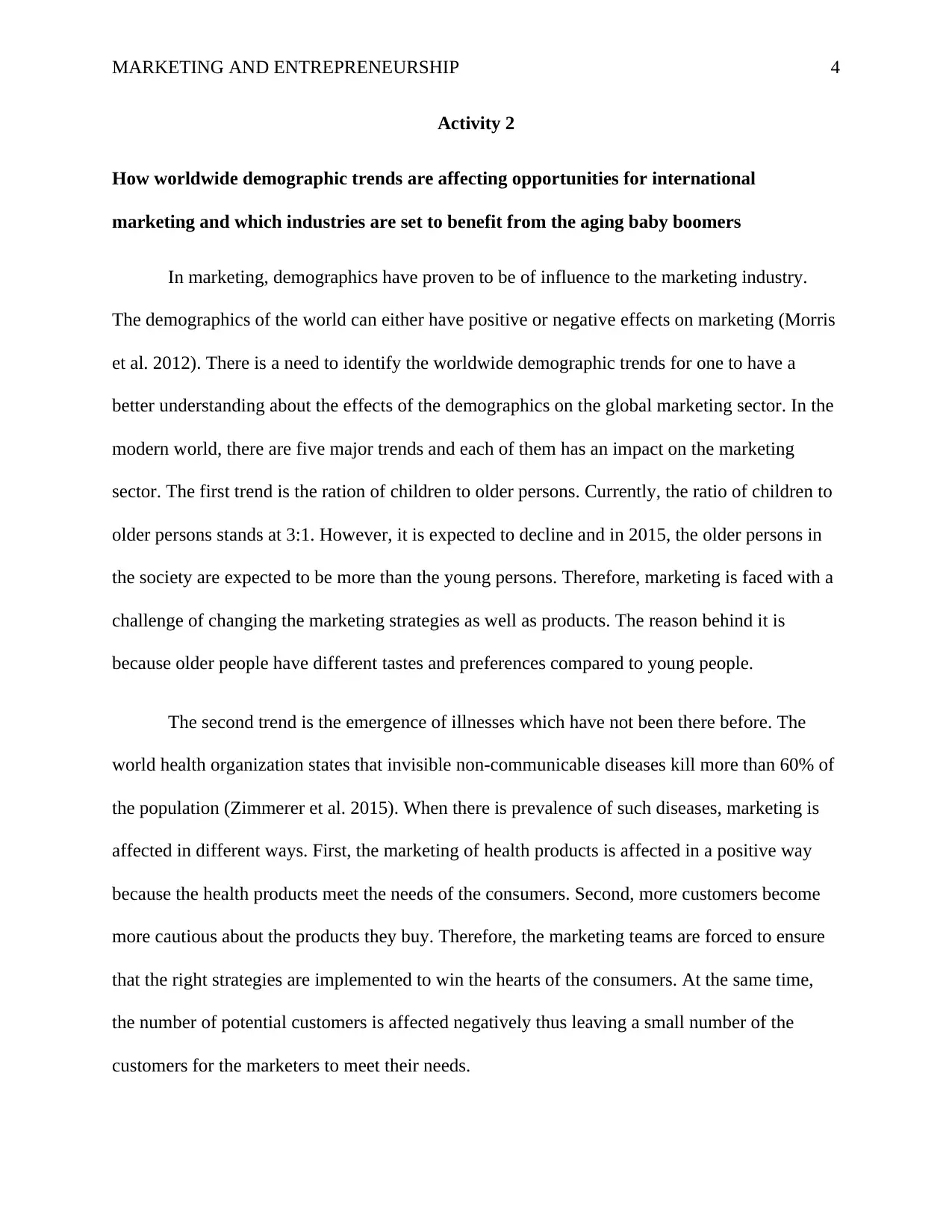
MARKETING AND ENTREPRENEURSHIP 4
Activity 2
How worldwide demographic trends are affecting opportunities for international
marketing and which industries are set to benefit from the aging baby boomers
In marketing, demographics have proven to be of influence to the marketing industry.
The demographics of the world can either have positive or negative effects on marketing (Morris
et al. 2012). There is a need to identify the worldwide demographic trends for one to have a
better understanding about the effects of the demographics on the global marketing sector. In the
modern world, there are five major trends and each of them has an impact on the marketing
sector. The first trend is the ration of children to older persons. Currently, the ratio of children to
older persons stands at 3:1. However, it is expected to decline and in 2015, the older persons in
the society are expected to be more than the young persons. Therefore, marketing is faced with a
challenge of changing the marketing strategies as well as products. The reason behind it is
because older people have different tastes and preferences compared to young people.
The second trend is the emergence of illnesses which have not been there before. The
world health organization states that invisible non-communicable diseases kill more than 60% of
the population (Zimmerer et al. 2015). When there is prevalence of such diseases, marketing is
affected in different ways. First, the marketing of health products is affected in a positive way
because the health products meet the needs of the consumers. Second, more customers become
more cautious about the products they buy. Therefore, the marketing teams are forced to ensure
that the right strategies are implemented to win the hearts of the consumers. At the same time,
the number of potential customers is affected negatively thus leaving a small number of the
customers for the marketers to meet their needs.
Activity 2
How worldwide demographic trends are affecting opportunities for international
marketing and which industries are set to benefit from the aging baby boomers
In marketing, demographics have proven to be of influence to the marketing industry.
The demographics of the world can either have positive or negative effects on marketing (Morris
et al. 2012). There is a need to identify the worldwide demographic trends for one to have a
better understanding about the effects of the demographics on the global marketing sector. In the
modern world, there are five major trends and each of them has an impact on the marketing
sector. The first trend is the ration of children to older persons. Currently, the ratio of children to
older persons stands at 3:1. However, it is expected to decline and in 2015, the older persons in
the society are expected to be more than the young persons. Therefore, marketing is faced with a
challenge of changing the marketing strategies as well as products. The reason behind it is
because older people have different tastes and preferences compared to young people.
The second trend is the emergence of illnesses which have not been there before. The
world health organization states that invisible non-communicable diseases kill more than 60% of
the population (Zimmerer et al. 2015). When there is prevalence of such diseases, marketing is
affected in different ways. First, the marketing of health products is affected in a positive way
because the health products meet the needs of the consumers. Second, more customers become
more cautious about the products they buy. Therefore, the marketing teams are forced to ensure
that the right strategies are implemented to win the hearts of the consumers. At the same time,
the number of potential customers is affected negatively thus leaving a small number of the
customers for the marketers to meet their needs.
Paraphrase This Document
Need a fresh take? Get an instant paraphrase of this document with our AI Paraphraser
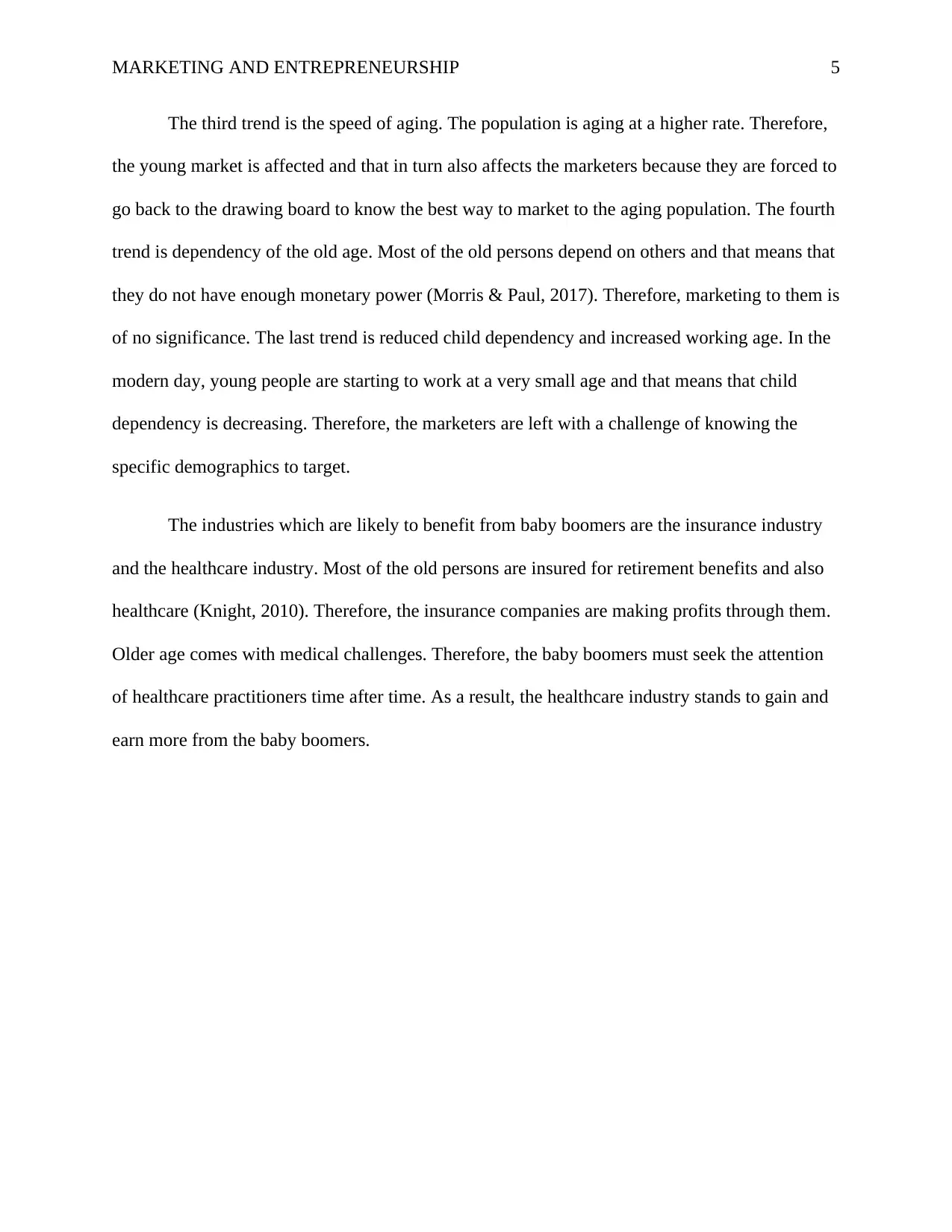
MARKETING AND ENTREPRENEURSHIP 5
The third trend is the speed of aging. The population is aging at a higher rate. Therefore,
the young market is affected and that in turn also affects the marketers because they are forced to
go back to the drawing board to know the best way to market to the aging population. The fourth
trend is dependency of the old age. Most of the old persons depend on others and that means that
they do not have enough monetary power (Morris & Paul, 2017). Therefore, marketing to them is
of no significance. The last trend is reduced child dependency and increased working age. In the
modern day, young people are starting to work at a very small age and that means that child
dependency is decreasing. Therefore, the marketers are left with a challenge of knowing the
specific demographics to target.
The industries which are likely to benefit from baby boomers are the insurance industry
and the healthcare industry. Most of the old persons are insured for retirement benefits and also
healthcare (Knight, 2010). Therefore, the insurance companies are making profits through them.
Older age comes with medical challenges. Therefore, the baby boomers must seek the attention
of healthcare practitioners time after time. As a result, the healthcare industry stands to gain and
earn more from the baby boomers.
The third trend is the speed of aging. The population is aging at a higher rate. Therefore,
the young market is affected and that in turn also affects the marketers because they are forced to
go back to the drawing board to know the best way to market to the aging population. The fourth
trend is dependency of the old age. Most of the old persons depend on others and that means that
they do not have enough monetary power (Morris & Paul, 2017). Therefore, marketing to them is
of no significance. The last trend is reduced child dependency and increased working age. In the
modern day, young people are starting to work at a very small age and that means that child
dependency is decreasing. Therefore, the marketers are left with a challenge of knowing the
specific demographics to target.
The industries which are likely to benefit from baby boomers are the insurance industry
and the healthcare industry. Most of the old persons are insured for retirement benefits and also
healthcare (Knight, 2010). Therefore, the insurance companies are making profits through them.
Older age comes with medical challenges. Therefore, the baby boomers must seek the attention
of healthcare practitioners time after time. As a result, the healthcare industry stands to gain and
earn more from the baby boomers.
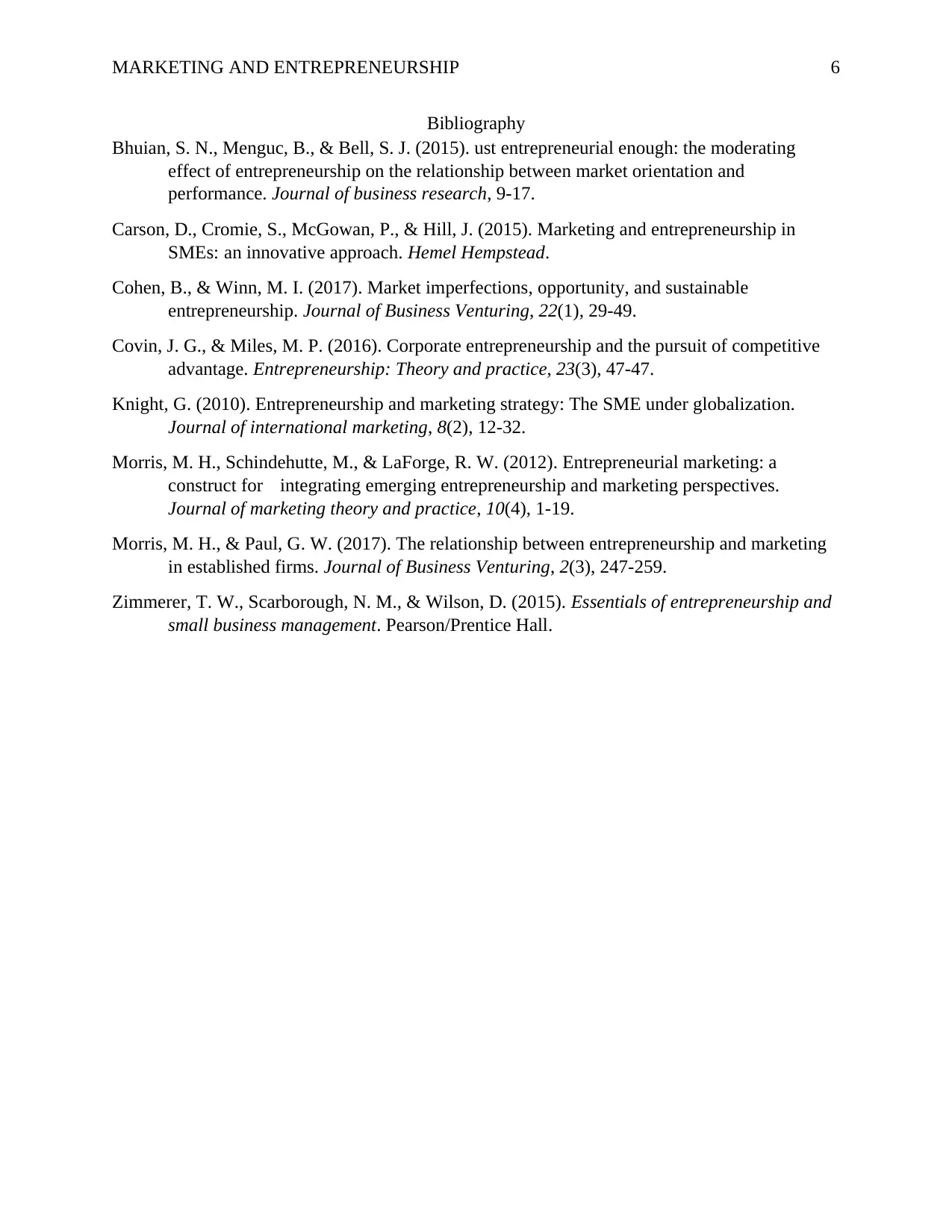
MARKETING AND ENTREPRENEURSHIP 6
Bibliography
Bhuian, S. N., Menguc, B., & Bell, S. J. (2015). ust entrepreneurial enough: the moderating
effect of entrepreneurship on the relationship between market orientation and
performance. Journal of business research, 9-17.
Carson, D., Cromie, S., McGowan, P., & Hill, J. (2015). Marketing and entrepreneurship in
SMEs: an innovative approach. Hemel Hempstead.
Cohen, B., & Winn, M. I. (2017). Market imperfections, opportunity, and sustainable
entrepreneurship. Journal of Business Venturing, 22(1), 29-49.
Covin, J. G., & Miles, M. P. (2016). Corporate entrepreneurship and the pursuit of competitive
advantage. Entrepreneurship: Theory and practice, 23(3), 47-47.
Knight, G. (2010). Entrepreneurship and marketing strategy: The SME under globalization.
Journal of international marketing, 8(2), 12-32.
Morris, M. H., Schindehutte, M., & LaForge, R. W. (2012). Entrepreneurial marketing: a
construct for integrating emerging entrepreneurship and marketing perspectives.
Journal of marketing theory and practice, 10(4), 1-19.
Morris, M. H., & Paul, G. W. (2017). The relationship between entrepreneurship and marketing
in established firms. Journal of Business Venturing, 2(3), 247-259.
Zimmerer, T. W., Scarborough, N. M., & Wilson, D. (2015). Essentials of entrepreneurship and
small business management. Pearson/Prentice Hall.
Bibliography
Bhuian, S. N., Menguc, B., & Bell, S. J. (2015). ust entrepreneurial enough: the moderating
effect of entrepreneurship on the relationship between market orientation and
performance. Journal of business research, 9-17.
Carson, D., Cromie, S., McGowan, P., & Hill, J. (2015). Marketing and entrepreneurship in
SMEs: an innovative approach. Hemel Hempstead.
Cohen, B., & Winn, M. I. (2017). Market imperfections, opportunity, and sustainable
entrepreneurship. Journal of Business Venturing, 22(1), 29-49.
Covin, J. G., & Miles, M. P. (2016). Corporate entrepreneurship and the pursuit of competitive
advantage. Entrepreneurship: Theory and practice, 23(3), 47-47.
Knight, G. (2010). Entrepreneurship and marketing strategy: The SME under globalization.
Journal of international marketing, 8(2), 12-32.
Morris, M. H., Schindehutte, M., & LaForge, R. W. (2012). Entrepreneurial marketing: a
construct for integrating emerging entrepreneurship and marketing perspectives.
Journal of marketing theory and practice, 10(4), 1-19.
Morris, M. H., & Paul, G. W. (2017). The relationship between entrepreneurship and marketing
in established firms. Journal of Business Venturing, 2(3), 247-259.
Zimmerer, T. W., Scarborough, N. M., & Wilson, D. (2015). Essentials of entrepreneurship and
small business management. Pearson/Prentice Hall.
⊘ This is a preview!⊘
Do you want full access?
Subscribe today to unlock all pages.

Trusted by 1+ million students worldwide
1 out of 6
Related Documents
Your All-in-One AI-Powered Toolkit for Academic Success.
+13062052269
info@desklib.com
Available 24*7 on WhatsApp / Email
![[object Object]](/_next/static/media/star-bottom.7253800d.svg)
Unlock your academic potential
Copyright © 2020–2025 A2Z Services. All Rights Reserved. Developed and managed by ZUCOL.





